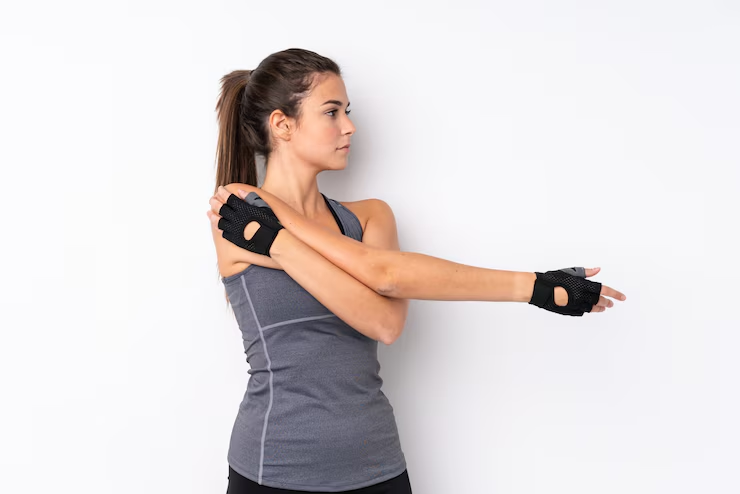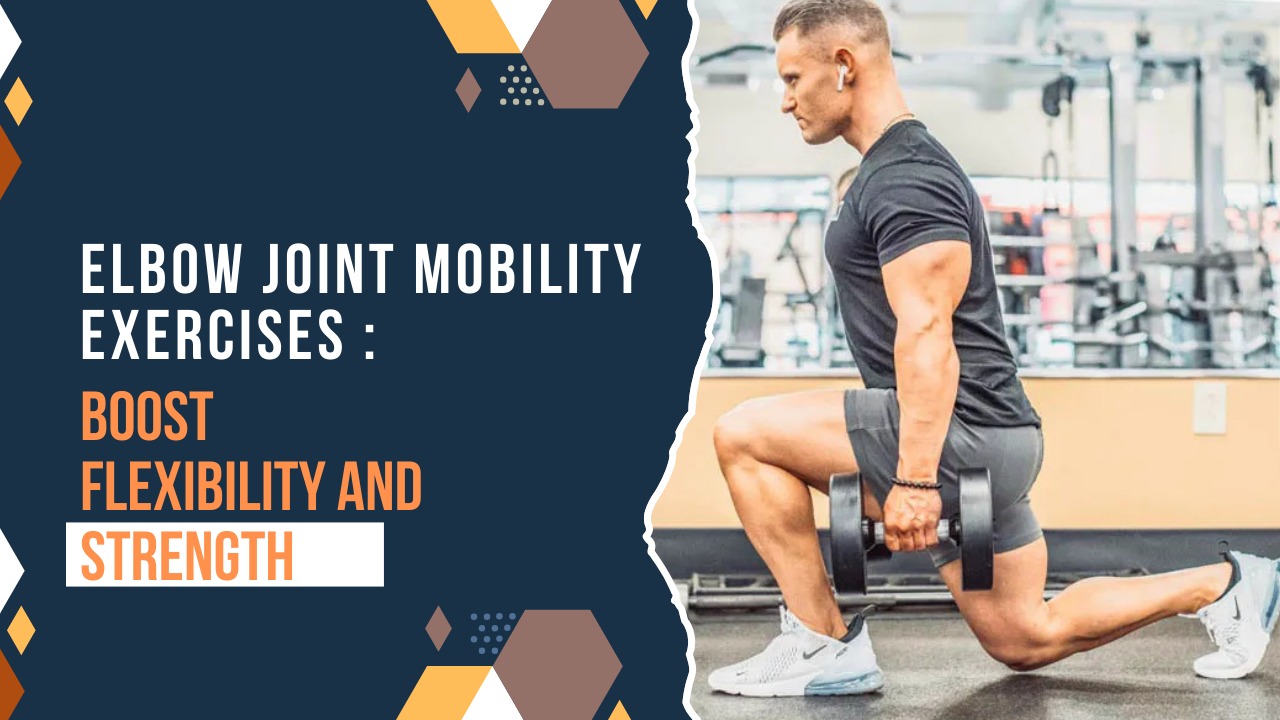The elbow joint is a crucial hinge that allows for bending, straightening, and rotating the arm. It connects the upper arm (humerus) to the forearm bones (radius and ulna), playing a key role in almost every upper-body movement—from lifting groceries to performing push-ups. Despite its importance, the elbow is often neglected in mobility routines until pain or stiffness appears.
Poor elbow joint mobility can lead to restricted motion, discomfort, and even overcompensation in surrounding muscles and joints like the shoulder or wrist. This can affect both daily activities and athletic performance. Whether you’re an athlete, office worker, or simply aging, maintaining flexibility and function in the elbow is essential.
Including regular elbow joint mobility exercises into your routine can prevent stiffness, reduce pain, and improve performance. These exercises enhance circulation, loosen tight tissues, and support joint health—helping you maintain strength, fluid movement, and long-term elbow function.
In this article, we’ll explore everything you need to know about elbow mobility: how the joint works, the benefits of mobility exercises, causes of stiffness or pain, and the top 8 elbow mobility exercises with tips for performing them effectively. Let’s dive in.

Understanding the Elbow Joint
The elbow is a hinge-type synovial joint, composed of three bones:
Humerus (upper arm)
Radius (forearm, thumb side)
Ulna (forearm, pinky side)
These bones form three distinct joints:
Humeroulnar joint – flexion and extension
Humeroradial joint – stability and movement
Proximal radioulnar joint – rotation (pronation/supination)
Supporting these joints are ligaments, tendons, muscles (like biceps, triceps, and forearm flexors/extensors), and a joint capsule.
When working properly, the elbow allows:
Flexion/Extension – bending and straightening
Pronation/Supination – turning the palm up or down
Overuse, injury, or poor posture can limit these movements, causing tightness, discomfort, and loss of function.
Why Elbow Joint Mobility Matters
✅ Improved Range of Motion: Consistently practicing elbow joint mobility exercises helps maintain and restore the full bending and extending capacity of the elbow. This makes everyday tasks like lifting, pushing, or pulling smoother and more efficient.
✅ Injury Prevention: By promoting muscular balance and flexibility, elbow joint mobility exercises reduce the risk of common elbow injuries such as tennis elbow, golfer’s elbow, or tendonitis. Keeping the joint mobile ensures less strain during repetitive or high-impact movements.
✅ Enhanced Athletic Performance: Athletes in sports like tennis, golf, baseball, and weightlifting rely heavily on elbow function. Improved mobility through targeted elbow joint mobility exercises enhances strength, control, and technique, leading to better performance and endurance.
✅ Better Posture and Alignment: Elbow mobility influences how your wrists and shoulders function. Regular elbow joint mobility exercises support optimal upper body mechanics, contributing to better posture and reducing compensatory movement patterns.
✅ Pain Reduction and Healing: Gentle elbow joint mobility exercises stimulate circulation, reduce joint stiffness, and promote recovery from inflammation or overuse. This helps relieve chronic pain and maintain joint comfort over time.
Top Elbow Joint Mobility Exercises
Here are the best exercises to improve elbow joint health, strength, and flexibility. These can be performed daily or as part of a warm-up/cool-down routine.
Elbow Flexion and Extension Stretch
The Elbow Flexion and Extension Stretch is a foundational movement in elbow joint mobility exercises, designed to restore the elbow’s full range of motion. This stretch targets the muscles and tendons that control bending and straightening of the elbow, which are essential for functional daily activities like lifting, reaching, or typing.

To perform the stretch, sit or stand upright and extend one arm straight out in front of you, palm facing up. Gently bend your elbow to bring your hand toward your shoulder, then slowly extend it back to a straight position. Repeat the movement 10–15 times per arm, ensuring you move through the full range without pain. Use controlled, smooth motions to avoid stressing the joint.
Regularly incorporating the Elbow Flexion and Extension Stretch into your elbow joint mobility exercises routine can help relieve stiffness, promote better circulation, and support healthy movement patterns. It’s especially useful for recovery after overuse or injury.
Purpose: Improve basic range of motion.
How to do it:
Sit or stand upright.
Bend your elbow fully so your palm moves toward your shoulder.
Hold for 5 seconds.
Straighten your arm fully.
Repeat 10–15 reps on each side.
Tip: Use a towel or resistance band for gentle support if range is limited.
Forearm Rotations (Pronation and Supination)
Forearm Rotations (Pronation and Supination) are key elbow joint mobility exercises that improve rotational movement between the radius and ulna—the two bones in the forearm. These motions are essential for tasks like turning doorknobs, using tools, or rotating your wrist to receive or release objects.
To perform this exercise, sit or stand with your elbow bent at a 90-degree angle and tucked into your side. Start with your palm facing upward (supination), then slowly rotate your forearm until your palm faces downward (pronation). Reverse the motion back to the starting position. Repeat 10–15 times per side using controlled, pain-free movements.
Adding forearm rotations to your elbow joint mobility exercises routine enhances flexibility and function in both the elbow and wrist. These movements help maintain joint health, reduce stiffness, and prevent overuse injuries, especially in individuals who perform repetitive arm tasks or suffer from restricted forearm rotation.
Purpose: Improve rotation of the forearm bones.
How to do it:
Sit with your elbow bent at 90 degrees, tucked at your side.
Rotate your forearm so your palm faces up (supination), then down (pronation).
Move slowly and with control.
Perform 2–3 sets of 15 reps.
Tip: Hold a light dumbbell or hammer for a greater challenge.
Wrist Flexor and Extensor Stretch
The Wrist Flexor and Extensor Stretch is an excellent addition to your elbow joint mobility exercises routine, as it targets the muscles that cross both the wrist and elbow joints. Tightness in the forearm muscles can restrict elbow movement and contribute to conditions like tennis elbow or golfer’s elbow.
To perform the stretch, extend one arm straight in front of you with the palm facing up. Use your opposite hand to gently pull back on the fingers, stretching the underside of the forearm (wrist flexors). Hold for 15–30 seconds, then switch to the palm-down position and gently pull the fingers back to stretch the top of the forearm (wrist extensors). Repeat on both arms 2–3 times.
Incorporating this stretch into your regular elbow joint mobility exercises can reduce forearm tightness, relieve elbow discomfort, and improve functional movement. It’s especially useful for those who type frequently, lift weights, or use tools daily.
Purpose: Target the muscles crossing the elbow into the wrist.
How to do it:
Extend your arm with palm facing up.
Use the other hand to gently pull fingers back (wrist extension stretch).
Reverse the palm to face down, and repeat (wrist flexion stretch).
Hold each for 20–30 seconds.
Tip: Perform after long typing sessions or lifting weights.
Triceps Mobilization on Foam Roller
Triceps Mobilization on a Foam Roller is a powerful addition to your elbow joint mobility exercises routine, especially if you experience stiffness or tension in the back of the upper arm. The triceps muscle crosses the shoulder and elbow joints, so releasing it can significantly improve elbow flexibility and reduce discomfort during extension movements.

To perform this exercise, sit on the floor and place a foam roller behind you. Position the back of your upper arm (triceps) on the roller while supporting yourself with your legs and opposite hand. Slowly roll up and down from your shoulder to just above your elbow. Pause and hold on any tight or tender spots for 15–30 seconds to allow the tissue to release.
Incorporating triceps mobilization into your elbow joint mobility exercises routine helps reduce muscle tension, improve circulation, and restore smooth elbow movement. It’s especially helpful for athletes, lifters, or anyone experiencing tightness from repetitive arm use.
Purpose: Release tension in triceps that affects elbow movement.
How to do it:
Sit on the floor with a foam roller under your upper arm (triceps).
Roll back and forth slowly, pausing at tender spots.
Spend 1–2 minutes per arm.
Tip: Support yourself with the opposite hand and feet to adjust pressure.
Active Elbow Circles
Active Elbow Circles are a simple yet effective movement that belongs in any routine of elbow joint mobility exercises. This exercise helps lubricate the joint, improve neuromuscular control, and increase circulation to the surrounding muscles and tendons. It’s especially beneficial during warm-ups or as a recovery drill.
To perform Active Elbow Circles, stand or sit comfortably with your elbows bent at a 90-degree angle and tucked close to your sides. Begin making small circular motions with your forearms while keeping the upper arms still. Rotate clockwise for 10–15 seconds, then switch to counterclockwise. Keep the motion smooth and controlled throughout the movement.
Regularly performing Active Elbow Circles as part of your elbow joint mobility exercises routine can help relieve stiffness, enhance joint function, and prevent overuse injuries. This dynamic movement prepares the elbow for physical activity and supports long-term flexibility and strength in both athletic and daily activities.
Purpose: Activate surrounding muscles for warm-up.
How to do it:
Stand with your arms bent at 90 degrees.
Slowly rotate your elbows in small circles clockwise and counterclockwise.
Keep the movement controlled.
Do 10 reps each direction.
Tip: Keep shoulders relaxed and avoid shrugging.
Banded Elbow Distractions
Banded Elbow Distractions are an advanced technique used in elbow joint mobility exercises to improve joint space, reduce compression, and restore natural movement patterns. This exercise targets the elbow capsule, promoting better flexion and extension by gently pulling the joint apart to relieve pressure and improve mobility.
To perform this movement, anchor a resistance band at a low point and loop it around your forearm just below the elbow. Step back to create tension and kneel or stand while facing away from the anchor. Allow the band to gently pull your elbow forward while you extend and flex the arm slowly. Perform for 30–60 seconds on each arm with control and without pain.
Incorporating banded elbow distractions into your elbow joint mobility exercises can be especially effective for athletes, weightlifters, or those recovering from stiffness due to overuse. It promotes joint health, enhances range of motion, and supports long-term elbow function.
Purpose: Create space in the joint capsule to improve mobility.
How to do it:
Attach a resistance band to a fixed object.
Loop the other end around your forearm.
Face away and let the band gently pull your arm forward while you bend and extend the elbow.
Do 10–12 slow reps.
Tip: This is great for post-injury rehab under supervision.
Wall Slides with Elbow Extension
Wall Slides with Elbow Extension are a valuable addition to your elbow joint mobility exercises routine, combining shoulder and elbow movement to promote fluid, functional range of motion. This exercise helps stretch and activate the muscles that support elbow extension, especially after periods of immobility or repetitive strain.

To perform this movement, stand facing a wall with your forearms resting vertically on the surface, elbows bent at 90 degrees. Slowly slide your arms upward along the wall, extending your elbows as you reach higher. Focus on keeping your forearms in contact with the wall throughout the motion, then return to the starting position. Repeat for 10–15 reps.
Adding Wall Slides with Elbow Extension to your regular elbow joint mobility exercises routine improves coordination between the elbow and shoulder, enhances flexibility, and supports better arm mechanics. This exercise is especially useful for office workers, athletes, and individuals recovering from elbow stiffness or injury.
Purpose: Combine shoulder and elbow mobility.
How to do it:
Stand facing a wall with forearms flat against it.
Slide your arms upward while keeping elbows straight.
Return slowly.
Repeat for 10 reps.
Tip: Squeeze shoulder blades gently for added benefit.
Isometric Holds (Elbow Flexion/Extension)
Isometric Holds (Elbow Flexion/Extension) are a powerful way to build joint stability and control as part of your elbow joint mobility exercises routine. Isometrics involve activating the muscles without actual movement, which strengthens the elbow joint and surrounding muscles without causing strain or overuse.
To perform this exercise, start by bending your elbow to a 90-degree angle. Use your opposite hand or a wall to resist the motion as you attempt to flex or extend the elbow without actually moving it. Hold each contraction for 10–15 seconds, then relax. Repeat this 3–5 times in each direction for both arms.
Integrating Isometric Holds into your elbow joint mobility exercises helps activate dormant muscles, build endurance, and improve joint stability. These holds are ideal during early rehabilitation stages or when motion causes discomfort, making them suitable for people recovering from injury or dealing with chronic elbow stiffness.
Purpose: Build strength in end ranges.
How to do it:
Bend your elbow to 90 degrees and hold a light weight.
Hold for 15–30 seconds.
Repeat at various angles (45°, full extension, full flexion).
Don’t push into pain; stay within comfortable range.
Tips For Effective Elbow Mobility Training
✅Be Consistent: Lasting improvements in flexibility and function come from repetition. Aim to practice elbow joint mobility exercises for at least 5–10 minutes daily to maintain and gradually improve joint health.
✅Warm Up First: Never perform elbow joint mobility exercises on cold muscles or joints. Begin with light cardio or dynamic arm movements to increase circulation and prepare the tissues for stretching.
✅Use Proper Technique: Controlled, mindful movement is essential. Performing elbow joint mobility exercises with proper form ensures you target the right muscles and avoid unnecessary strain or injury.
✅Don’t Push Through Pain: Mild stretching discomfort is okay, but sharp or persistent pain is a warning sign. Modify or skip any elbow joint mobility exercises that cause pain and consult a professional if it persists.
✅Combine Mobility with Strength: Balanced training is key. Along with elbow joint mobility exercises, include strength training to build muscle support around the elbow for better stability and function.
✅ Address the Whole Chain: The elbow doesn’t work in isolation. Include exercises for the shoulder and wrist along with elbow joint mobility exercises to ensure full upper-limb coordination and mobility.
✅Progress Gradually: Increase resistance, repetitions, or complexity over time as your joint adapts. Rushing mobility work can lead to setbacks, so build your elbow joint mobility exercises program steadily.
✅Seek Professional Help: If you experience chronic elbow pain, reduced motion, or past injuries, get a personalized plan. A physiotherapist can guide you on safe and effective elbow joint mobility exercises for your condition.
Conclusion
Your elbow joint may be small, but its role in everyday function is enormous. From lifting and typing to pushing and pulling, this hinge joint is constantly at work. Unfortunately, it’s also prone to stiffness and overuse injuries. That’s why incorporating regular elbow joint mobility exercises is essential for maintaining comfort and long-term joint health.

By dedicating just a few minutes a day to elbow joint mobility exercises, you can improve your range of motion, prevent injuries like tennis elbow, and reduce chronic discomfort. These exercises enhance circulation, loosen tight tissues, and keep the joint functioning smoothly—whether you’re an athlete or someone who spends hours at a desk.
Whether you’re recovering from an injury or simply aiming to stay flexible and pain-free, now is the time to make mobility a priority. Use the stretches, isometrics, and tips shared above to build your routine and commit to better health with daily elbow joint mobility exercises.
FAQs
Q1. What are elbow joint mobility exercises?
Elbow joint mobility exercises are movements designed to improve flexibility, range of motion, and function of the elbow. These include stretches, dynamic movements, and isometric holds that target the muscles and tissues surrounding the elbow, helping to relieve stiffness and reduce the risk of injury.
Q2. Who should do elbow joint mobility exercises?
Everyone can benefit from elbow joint mobility exercises, especially office workers, athletes, weightlifters, and those recovering from elbow injuries. These exercises are also helpful for people experiencing stiffness, discomfort, or limited range of motion due to repetitive use or aging.
Q3. How often should I perform elbow joint mobility exercises?
For the best results, perform elbow joint mobility exercises 3 to 5 times per week. Consistency is key to seeing improvements in flexibility and joint health. Even 5–10 minutes a day can lead to noticeable benefits over time.
Q4. Can elbow joint mobility exercises help with pain relief?
Yes, many people find that elbow joint mobility exercises reduce or eliminate discomfort caused by overuse, inflammation, or poor posture. These exercises improve circulation, loosen tight muscles, and restore proper movement, which can ease chronic or acute elbow pain.
Q5. Are elbow joint mobility exercises safe for injury recovery?
Most elbow joint mobility exercises are safe when performed correctly and within a pain-free range. However, if you have a serious injury or surgery history, it’s best to consult a physiotherapist for a tailored program to ensure safe rehabilitation.



